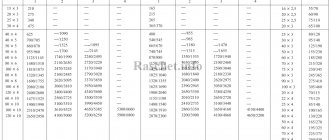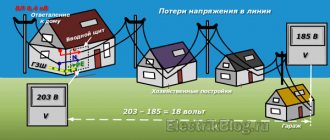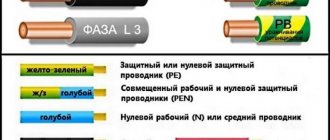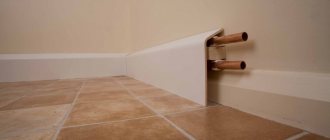Carrying out calculations
Therefore, the volume is calculated by multiplying the internal cross-sectional area of the pipe by its length.
The cross-section of pipelines most often has the shape of a circle, the area of which is equal to the product of the square of the radius and the number π = 3.14. Or, alternatively, the product of π by the square of the diameter divided by 4. The formula for the volume of a cylinder (in our case, water) looks like this:
Thus, the volume of water in the pipe is equal to the product of the cross-sectional area and the length of the pipe in meters. The resulting value will show the amount of water in m3.
Let's look at how to calculate the volume of a pipe not in cubic meters, but in liters. To calculate, you need to multiply its volume by 1000, which is exactly how many liters one cubic meter holds. You can immediately calculate the volume of the pipeline in liters, but to do this, all length measurements must be made in decimeters, and the pipe area must also be calculated in square decimeters. This is inconvenient and will probably cause confusion, so it’s easier to find cubic meters and multiply them by 1000. The following formula or an online calculator, of which there are many on the Internet, will help you calculate the volume of a pipe in m3. They all operate on the same principle - you need to enter your data in the empty fields, press a button, and the system will instantly give the correct result.
Cross-sectional area
S = 0.785 × D2
In this case, the situation will look somewhat more complicated than it seems at first. The fact is that for the calculation you need an internal diameter, which is measured with an ordinary caliper. How to find the volume of liquid if the thickness of the pipe walls is unknown and only the outer diameter is available.
If it is not possible to measure the internal diameter, then you have to either use the estimated value, or make two (or more) calculations from which to select the most appropriate value.
The wall thickness can be one or two millimeters; for large-diameter products, the thickness can be up to 5 mm. With a long length, the volume of a pipeline with thick walls differs significantly from the volume of thin-walled pipes. In some situations it is important to find the exact value, for example, calculating the amount of coolant in the underfloor heating system, the heating circuit of the house
For those who find it difficult to calculate the area of a pipe, an online calculator (and more than one) has been created. It is easy to find on the Internet and, by substituting your own data in the program windows, you can easily and quickly obtain the necessary values.
How much fluid is in the system
Let's look at how to calculate the amount of water or other liquid in the entire system. The simplest option is to calculate the cross-sectional area and multiply it by the total length of the pipeline. However, there are no systems consisting of pipes alone. In addition, the pipelines are also different, which can change the desired value up or down.
- pipelines;
- radiators, convectors or other heating devices;
- gate valves, ball valves, other shut-off equipment.
If we are talking about the system of a private house, then additional elements will have to be taken into account:
- heating boiler;
- expansion tank;
- underfloor heating system (if there is one);
- heating manifold, control unit;
- fittings, adapters and other additional elements.
In this way, the capacity of all pipeline sections is calculated. The internal capacity of the fittings can be found online or calculated yourself.
For control units, manifolds and other devices, the data is indicated in the documentation: technical data sheet, user manual or other accompanying documents. The volume of the entire system is the sum of the dimensions of all its elements.
Internal volume
The table below greatly simplifies the calculation of the volume of water in 1 meter of pipe. It contains pipeline parameters and volumes of 1 and 10 linear meters. The values are given in liters, since most problems arise precisely at the stage of converting cubic meters into liters. Instead of struggling with a calculator and counting the amount of water in 1 linear meter, the table immediately gives the desired value; you just need to measure the internal diameter. If this is not possible, the system is assembled and is already functioning, then you can subtract 2 or 4 mm from the existing diameter and find the required value.
From the table you can obtain data on all existing standard sizes of pipes with an internal diameter from 4 to 1000 mm. These are the most common options, and others are unlikely to be needed. The data is quite accurate and can provide a very high-quality calculation of the parameters of a system or an individual pipe.
Weight calculation
When calculating the weight of a pipe, everything is simple: you need to know how much a linear meter weighs, then multiply this value by the length in meters. The weight of round steel pipes is in reference books, since this type of rolled metal is standardized. The weight of one linear meter depends on the diameter and wall thickness. One point: the standard weight is given for steel with a density of 7.85 g/cm2 - this is the type recommended by GOST.
Round Steel Pipe Weight Table
In table D - outer diameter, nominal diameter - inner diameter, And one more important point: the weight of ordinary rolled steel is indicated; galvanized steel is 3% heavier.
Weight table for profiled square pipe
How to calculate the cross-sectional area of a chimney?
Features of the cross section
There are several methods for calculating the optimal cross section. For example, on the size of the combustion chamber of the hearth or on the area of the furnace blower window
But in this publication, attention will be focused on the methodology, which is based on assessing the volume of flue gases generated during the combustion process
The combustion of wood and other solid fuels is always accompanied by very significant smoke formation. And the chimney pipe must be able to discharge these volumes outside in a timely manner.
Based on calculations and experiments, experts have long compiled tables from which information can be obtained on specific smoke production for different types of solid fuel. That is, what volume of combustion products is formed when burning, say, one kilogram of firewood, coal, peat, etc.
We will also present such a table (in an abbreviated version). In addition to the specific smoke formation, it shows the calorie content of the fuel (the amount of heat released when burning one kilogram) and the approximate temperature of the combustion products at the exit from the chimney. The first of these characteristics does not particularly interest us at a given moment - it simply gives a general idea of fuel efficiency. But the temperature, yes, will be needed for calculations.
| Fuel type | Specific caloric content of fuel, kcal/kg, average | Specific volume of combustion products released from combustion 1 kg, m³ | Recommended temperature at the chimney outlet, °C |
| Firewood with an average humidity level - 25% | 3300 | 10 | 150 |
| Lump peat (in bulk), air-dried, with an average moisture level of no higher than 30% | 3000 | 10 | 130 |
| Peat - briquettes | 4000 | 11 | 130 |
| Brown coal | 4700 | 12 | 120 |
| Coal | 5200 | 17 | 110 |
| Anthracite | 7000 | 17 | 110 |
| Pellets or wood briquettes | 4800 | 9 | 150 |
As you can see, the volumes are impressive. Even types of fuel that produce minimal smoke are already about 10 cubic meters for every kilogram burned. This means, simply for reasons of physics and geometry, the cross-section of the chimney duct must be able to constantly drain these considerable volumes out.
This is why we “dance” when calculating.
Chimney prices
chimney
The volume of combustion products released when burning solid fuel for an hour can be determined by the following formula (taking into account the thermal expansion of gases).
Vgch = Vud × Mch × (1 + Td/273))
Vgch is the volume of combustion products formed within an hour.
Vsp is the specific volume of combustion products generated for the selected type of fuel, m³/kg (from the table).
Mtch is the mass of the fuel charge burned within one hour. It is usually found by the ratio of the full fuel load to the time of its complete burnout. For example, 12 kg of firewood is loaded into the stove at once, and it burns out in 3 hours. This means Mtch = 12 / 3 = 4 kg/hour.
Td - gas temperature (℃) at the outlet of the chimney pipe (from the table).
273 is a constant for bringing temperature parameters to the Kelvin scale, used in thermodynamic calculations.
Since the unit of time in our calculation system is a second, it is not difficult to find out the volume obtained per second - the result is simply divided by 3600:
Vgc = Vgch / 3600
To find out the cross-sectional area of a channel that is guaranteed to pass this volume through itself at a certain speed of gas movement, it is necessary to find their ratio
Sc = Vgс / Fд
Sc is the cross-sectional area of the chimney channel, m².
Fd - gas flow speed in the chimney pipe, m/s
A few words about this speed. For heating appliances and household-grade structures, they usually aim to stay in the range from 1.5 to 2.5 m/s. With such a low speed, on the one hand, there is no significant resistance to the flow, and no strong turbulences arise that slow down the movement of gases. Heat losses are minimized, the temperature of gases at the outlet of the pipe is reduced to normal values. At the same time, the speed is sufficiently high to reduce the formation of condensation and the deposition of ash on the inner walls of the channel.
If the cross-section is found (and this is its minimum value), then using known geometric formulas you can find either the diameter for a pipe with a round cross-section, or the side length for a square cross-section, or select the lengths of the sides for a rectangular one.
Below is a calculator that will greatly simplify these calculations. It must indicate the type of fuel, its approximate consumption (more precisely, the mass and burning time of a full load) and the expected flow rate of gases in the chimney. The program will do the rest itself.
The final result is shown in three views:
— minimum diameter for a round section;
— minimum side length for a square section;
- cross-sectional area, according to which you can, for example, select the dimensions of the sides for a rectangular section.
How to make a calculation?
How to calculate the area of a pipe
Calculating the cross section
Determining the cross-section of a pipe is a simple geometric task. To do this, you should first use the formula for the area of a circle:
Sн= π Rн^2, (1)
where Rн is the outer radius of the pipe, equal to half the outer diameter.
Thus, we determine the area of the circle formed by the outer diameter.
Now let's determine the area of the circle formed by the inner diameter of the pipe. To do this, it is necessary to determine the internal radius, which is determined by the following formula:
Rin=Rn-?, (2)
Where? – pipe wall thickness.
Having determined the area of the inner circle Sе similarly to formula (1), we calculate the cross-sectional area using the formula:
Ssec=Sn?-S?in.
All actions can be summarized in a simplified formula for determining the cross-sectional area:
Ssec=? (?D_н/2?^2- ??/2?^2).
As an example, let us determine the cross-sectional area, the outer diameter of which is 1 meter and the wall thickness is 10 mm.
Ssec=3.14 (?1/2?^2-?0.01/2?^2)=0.75 m^2.
We calculate the area of the external surface
This calculation is also a geometric problem. If you unfold the pipe, you get a rectangle. Its width is equal to the circumference of the outer wall of the pipe, and its length is equal to the length.
Then the development area of the pipe will be calculated by the formula:
S=? D_n L_tr,
where Ltr is the length of the pipe.
As an example, let’s calculate the surface area for painting a heating main, the length of which is 10 km, and the outer diameter is 1 meter.
S=3.13 1 10000=31416 m^2.
If we talk about the amount of thermal insulation material, then when calculating, we should take into account the thickness of the mineral wool layer.
Then the formula will take the form:
S=? ?(D?_н+?2 ??_(в)) L_tr,
where?_in-thickness of the mineral wool layer.
In reality, less material will be wasted for thermal insulation, since it is overlapped.
We calculate the area of the internal surface
First you need to decide why such a calculation should be carried out. Most often it is needed when calculating the hydrodynamics of coolant movement in a pipe. The inner surface of the pipe is the place where water, as it moves, comes into contact with the pipe. Thus, hydraulic resistance arises, which must be taken into account when calculating the communication network.
It is necessary to remember a number of the following nuances:
- As the pipeline diameter increases, the hydraulic friction of the coolant against the pipe walls decreases. Therefore, with a large diameter and length of the water supply system, the hydraulic resistance of the pipe to the flow of water can be ignored.
- The quality of the surface, its roughness, has a great impact on the value of hydraulic resistance. Moreover, this influence is stronger than the dependence of resistance on the surface area of the inner wall of the pipeline. Thus, a polyethylene pipe has less roughness than a rusty metal pipe. Therefore, the amount of hydraulic resistance in a plastic pipe will be less.
- If non-galvanized steel is used as the material for making the pipe, the surface area of the inner wall changes over time. Rust and mineral deposits are gradually deposited on the walls of such a pipeline. As a result, the internal diameter of the pipe decreases and the hydraulic resistance increases. This effect must be taken into account when designing steel water pipes.
S=? ?(D?_n-2 ?) L_tr.
As an example, let's calculate a pipe whose diameter is one meter and the wall thickness is 10 mm.
S=3.14 (1-2 0.01) 10000=30788 m^2.
Conclusion
So, the calculations given in the article are not complicated and are accessible to anyone. They will come in handy when designing your own pipeline. In order for the constructed communication to meet the expectations of its performance, the proposed calculations must be made without fail.
Today we have a short excursion into school geometry and physics programs. We will recall how the cross-sectional area of a pipe and its internal volume are calculated. In addition, we have to find out how changes in the diameter of the pipeline affect the pressure in the fluid flow. So, let's go.
The photo shows water and gas pipes. We have to learn how to calculate their internal cross-section.
Calculation of sewer pipe capacity
How to correctly calculate the area to be painted for different types of pipes?
When designing a sewer system, it is imperative to calculate the throughput of the pipeline, which directly depends on its type (sewage systems are either pressure or non-pressure). Hydraulic laws are used to carry out calculations. The calculations themselves can be carried out either using formulas or using appropriate tables.
For the hydraulic calculation of the sewer system, the following indicators are required:
- Pipe diameter – DN;
- The average speed of movement of substances is v;
- The magnitude of the hydraulic slope is I;
- Filling degree – h/DN.
The speed and maximum level of filling of domestic sewerage are determined from a table that can be written out as follows:
- 150-250 mm - h/DN is 0.6, and speed is 0.7 m/s.
- Diameter 300-400 mm - h/DN is 0.7, speed - 0.8 m/s.
- Diameter 450-500 mm - h/DN is 0.75, speed - 0.9 m/s.
- Diameter 600-800 mm - h/DN is 0.75, speed - 1 m/s.
- Diameter 900+ mm - h/DN is 0.8, speed - 1.15 m/s.
For a product with a small cross-section, there are standard indicators for the minimum pipeline slope:
- With a diameter of 150 mm, the slope should not be less than 0.008 mm;
- With a diameter of 200 mm, the slope should not be less than 0.007 mm.
To calculate the volume of wastewater, the following formula is used:
q = a*v,
Where a is the open cross-sectional area of the flow;
v – speed of wastewater transportation.
The speed of transport of a substance can be determined using the following formula:
v= C√R*i,
where R is the value of the hydraulic radius,
C – wetting coefficient;
i is the degree of slope of the structure.
From the previous formula we can derive the following, which will allow us to determine the value of the hydraulic slope:
i=v2/C2*R.
To calculate the wetting coefficient, a formula of the following form is used:
С=(1/n)*R1/6,
Where n is a coefficient that takes into account the degree of roughness, which varies from 0.012 to 0.015 (depending on the material of the pipe).
The R value is usually equated to the usual radius, but this is only relevant if the pipe is completely filled.
For other situations, a simple formula is used:
R=A/P,
Where A is the cross-sectional area of the water flow,
P is the length of the inner part of the pipe in direct contact with the liquid.
Why do we need calculations of pipe parameters?
In modern construction, not only steel or galvanized pipes are used. The choice is already quite wide - PVC, polyethylene (HDPE and LDPE), polypropylene, metal-plastic, corrugated stainless steel. They are good because they do not have as much mass as their steel counterparts. However, when transporting polymer products in large volumes, it is advisable to know their weight in order to understand what kind of machine is needed. The weight of metal pipes is even more important - delivery is calculated by tonnage. So it is advisable to control this parameter.
What cannot be measured can be calculated
It is necessary to know the outer surface area of the pipe to purchase paint and thermal insulation materials. Only steel products are painted, because they are susceptible to corrosion, unlike polymer ones. So you have to protect the surface from exposure to aggressive environments. They are used more often for the construction of fences, frames for outbuildings (garages, sheds, gazebos, cabins), so the operating conditions are difficult, protection is necessary, therefore all frames require painting. This is where the area of the surface to be painted is required - the outer area of the pipe.
When constructing a water supply system for a private house or cottage, pipes are laid from the water source (well or borehole) to the house - underground. And still, to keep them from freezing, insulation is required. You can calculate the amount of insulation by knowing the outer surface area of the pipeline. Only in this case it is necessary to take material with a substantial margin - the joints must overlap with a substantial margin.
The cross-section of the pipe is necessary to determine the throughput - whether this product can carry the required amount of liquid or gas. The same parameter is often needed when choosing the diameter of pipes for heating and plumbing, calculating pump performance, etc.
Calculation methods
Section calculation
Actually, the problem is something from middle school geometry. We need to calculate the area of a circle whose diameter is equal to the outer diameter of the pipe minus the thickness of its walls.
The area of a circle, as we remember, is calculated as S = Pi R^2.
Thus, the formula calculating the cross-sectional area of the pipe is S=Pi*(D/2-N)^2, where S is the internal cross-sectional area of the pipe, Pi is the pi number, D is the outer diameter of the pipe, and N is the wall thickness pipes. Diameter, as we remember, is two radii.
So, we have a formula that calculates the cross-sectional area of a pipe. Let's use it using the example of another spherical horse in a vacuum - a hot-rolled seamless pipe with an outer diameter of 1 meter and walls 10 mm thick.
S=3.14159265*(1/2-0.01)^2=0.754296 m2.
Sometimes a lot depends on the exact selection of pipe cross-section
Pipe outer surface area
And this is also a purely geometric problem. How to calculate the surface area of a pipe outside?
How can one find the area of the cylinder walls in general?
The surface of a cylinder is essentially a rectangle, one side of which is the circumference of the cylinder, and the other side is the length of the cylinder itself. So?
The circumference, as we remember, is equal to Pi * D, where Pi is the number Pi, and D is the diameter of the pipe.
How to calculate the area of a rectangle? It is necessary to multiply its length by its width.
The area of the coveted rectangle will be: S=Pi*D*L, where Pi is the good old Pi number, D is the diameter of the pipe, and L is its length.
For a heating main with a diameter of one meter and a length of ten kilometers, the painting area of the pipes will be equal to: 3.14159265*1*10000=31415.9265 m2. You will need a little more thermal insulation: it has a thickness other than zero, and the pipe is wrapped in mineral wool with overlapping sheets.
And here an accurate calculation of the surface area was necessary
Pipe inner surface area
Why the inner surface? Are pipes really painted from the inside?
No, the internal surface area can be useful in hydrodynamic calculations. This is the surface area that water comes into contact with as it moves through the pipes.
There are several nuances associated with this area:
- The larger the diameter of the water supply pipe, the less the influence of the roughness of its walls on the flow rate in it. For large-diameter pipelines with a short length, the resistance of the pipe can be completely neglected;
- For hydrodynamic calculations, surface roughness is no less important than its area. A steel water pipe that is rusty inside and a perfectly smooth polypropylene pipe has very different effects on the flow rate;
- Non-galvanized steel pipes have, so to speak, a variable internal surface area. Over time, they become overgrown with rust and mineral deposits, causing the opening to narrow. If you come up with a strange fantasy of making a cold water supply pipe out of steel, this fact cannot be neglected, since the permeability of a water pipe can drop by half in just ten years.
Overgrowth of non-galvanized steel pipes must be taken into account when calculating the water supply system
Well, what about the formula? It's simple. The diameter of the cylinder in this case, as you might guess, is equal to the difference between the diameter and twice the thickness of the pipe walls.
If so, the area of the cylinder walls takes the form S=Pi*(D-2N)*L, where D is still the diameter of the pipe, N is the thickness of its walls, and L is the length.
For a heating main 10 kilometers long from a pipe 1 meter in diameter with walls 10 mm thick, the internal surface area will be equal to: 3.14159265*(1-2*0.01)*10000 = 30787.60797 m2.
Inner and outer diameter, wall thickness, radius
Pipes are a specific product. They have an internal and external diameter, since their wall is thick, its thickness depends on the type of pipe and the material from which it is made. Technical specifications often indicate the outer diameter and wall thickness.
Pipe inner and outer diameter, wall thickness
Having these two values, it is easy to calculate the internal diameter - subtract twice the wall thickness from the external one: d = D - 2*S. If you have an outer diameter of 32 mm, a wall thickness of 3 mm, then the inner diameter will be: 32 mm - 2 * 3 mm = 26 mm.
If, on the contrary, there is an internal diameter and wall thickness, but an external one is needed, we add double the stack thickness to the existing value.
With radii (denoted by the letter R) it is even simpler - this is half the diameter: R = 1/2 D. For example, let’s find the radius of a pipe with a diameter of 32 mm. Just divide 32 by two, we get 16 mm.
Vernier caliper measurements are more accurate
What to do if there are no technical data for the pipe? To measure. If special accuracy is not needed, a regular ruler will do; for more accurate measurements, it is better to use a caliper.
Nominal pipe diameters
GOST 28338-89 clearly regulates the parameters and marking of all tubular products, regardless of the material of their manufacture. And one of the important ones here is the conditional passage of the tube. The nominal diameter (clearance, passage, DU) is the internal diameter of the product, which differs from the outer diameter due to the thickness of the walls of the product.
Understanding and knowing the size of the internal clearance (CL) of the tube, you can select all the connecting elements in such a way that the water supply system (sewerage, etc.) has a single and complete appearance without the risk of depressurization.
Based on this, it becomes clear that the nominal diameter of all products for installing a sewer or water main is the most important parameter that contributes to the assembly of a straight and high-quality operating system.
Important: initially the nominal diameter of the pipe was marked with the letters DU. Today this value is determined by the letters DN
Note that most often the dimensional parameters of prefabricated elements made of cast iron or steel are marked by the internal diameter (nominal clearance/DN), while rolled products made of polymers, copper and sometimes steel are marked by the outer diameter.
Dimensional chart of rolled pipes
All tubes produced in modern and foreign production are made in accordance with the size range, which has 49 options. In this case, the diameter (DN) of products varies from 2.5 mm to 4000 mm.
It is worth noting that only three types of tubes from the entire size grid can be used for the installation of hydraulic and pneumatic lines. These are elements with a diameter of 16, 63 and 160 mm. There are also five types of round sections that are not used as general purpose pipe fittings. These are hoses with diameters of 0.175 m, 2.6 m, 3.2 m, 3.6 and 3.8 m.
Such exceptions indicate that GOST 28338-89 has clear regulations for 40 standard and 8 specialized pipe dimensions.
Definition of marking
According to established norms and standards, today the nominal diameter is designated by the letters DN (formerly DU), and the clearance value is marked in mm. Thus, if in front of us lies a tube marked DN150, this does not mean at all that its internal lumen is equal to this value. This marking can mark elements with outer and inner diameters of 156/149 or elements with outer and inner sections of 156/144 mm. According to the table of permissible conditional values in GOST 28338-89, both the indicator 144 and the indicator 149 mm are rounded to a conventional section of 150 mm.
And to accurately calculate the nominal diameter of a pipeline, you can use the formula:
In the formula, the value D(ext) means the outer diameter of the circular element. S is the thickness of its wall.
For example, we have a section with a cross-section of DN110 mm and a wall thickness of 6 mm. You need to subtract 110 (6x2). We get an exact pipe clearance of 98 mm.
Nominal diameters for steel pipes
Rolled steel has conditional clearances, which are formed depending on the method of production of the elements. Therefore, there is a table of conditional values, which are reduced to the following values:
- For tubes made using hot rolling technology - 20-500 mm (in accordance with GOST 8732-78);
- If the products were produced using cold rolling technology, the values are narrowed to 5-250 mm (according to GOST 8734-75);
- Welded tubes with a longitudinal seam - 10-1400 mm (in accordance with GOST 10704-91);
- For welded pipe elements with a seam in the form of a spiral - 160-2400 mm (GOST 8696-74).
Important: all rolled steel has a 38-digit dimensional grid with conventional numerical values for each diameter. In addition, the range of steel products includes tubes with four special clearances, which are used for pneumatic and hydraulic lines
Conventional diameter values for polymer pipes
The parameters of polymer elements for a main (pipeline) of circular cross-section are regulated by GOST 18599-2001, which clearly states that the range of products can be manufactured in 32 standard sizes. Their size range is 10-1600 mm.
Moreover, all 32 types of size range of plastic products are additionally divided into four groups according to the wall thickness of the product. That, in turn, varies in the range of 2-70 mm. The pressure resistance inside the tube for rolled polymer products can be in the range of 0.16-2 MPa.
Thus, by understanding the internal nominal diameter of each element, it is possible to design the main line (pipeline) as accurately as possible, determining its internal pressure and network capacity.










